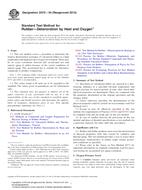We need your consent to use the individual data so that you can see information about your interests, among other things. Click "OK" to give your consent.
ASTM D572-04(2010)
Standard Test Method for Rubber-Deterioration by Heat and Oxygen
STANDARD published on 1.5.2010
The information about the standard:
Designation standards: ASTM D572-04(2010)
Note: WITHDRAWN
Publication date standards: 1.5.2010
SKU: NS-32274
The number of pages: 4
Approximate weight : 12 g (0.03 lbs)
Country: American technical standard
Category: Technical standards ASTM
Annotation of standard text ASTM D572-04(2010) :
Keywords:
elevated temperature, oxidative aging, pressure chamber, pressure vessel, rubber articles, rubber products, thermal aging, Accelerated aging/testing--rubber/related materials, Deterioration--rubber, Elevated temperature tests--rubber, Oxidative aging, Rubber aging, Thermal analysis (TA), ICS Number Code 83.060 (Rubber)
Additional information
| Significance and Use | ||||||||||||||||
|
Rubber and rubber products must resist the deterioration of physical properties with time caused by oxidative and thermal aging. This test method provides a way to assess these performance characteristics of rubber, under certain accelerated conditions as specified. Please refer to the Annex in Test Method D573 for important information on standard compounds used for precision testing for accelerated test aging evaluation. |
||||||||||||||||
| 1. Scope | ||||||||||||||||
|
1.1 This test method covers a procedure to determine the relative deterioration resistance of vulcanized rubber in a high temperature and high pressure oxygen environment. There may be no exact correlation between this accelerated test and natural aging of rubber because of the varied conditions of natural aging. This accelerated test is suitable for laboratory compound or product comparisons. Note 1—For evaluating rubber vulcanizates under less severe conditions more nearly approaching natural aging, the use of Test Methods D573 and D865 is recommended. 1.2 The values stated in SI units are to be regarded as the standard. The values given in parentheses are for information only. 1.3 This standard does not purport to address all of the safety concerns, if any, associated with its use. It is the responsibility of the user of this standard to establish appropriate safety and health practices and determine the applicability of regulatory limitations prior to use. (For specific precautionary statement, see Note 2.) |
||||||||||||||||
| 2. Referenced Documents | ||||||||||||||||
|
We recommend:
Technical standards updating
Do you want to make sure you use only the valid technical standards?
We can offer you a solution which will provide you a monthly overview concerning the updating of standards which you use.
Would you like to know more? Look at this page.




 Cookies
Cookies
